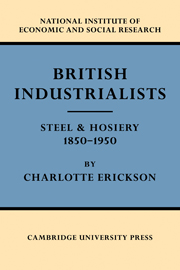Book contents
- Frontmatter
- Contents
- LIST OF TABLES
- Foreword
- Introduction
- I SCOPE OF THE INQUIRY
- II SOCIAL ORIGINS OF THE STEEL MANUFACTURERS
- III CAREERS OF THE STEEL MANUFACTURERS
- IV SOCIAL ORIGINS OF THE NOTTINGHAM HOSIERS
- V CAREERS OF THE HOSIERY MANUFACTURERS
- VI THE INTRODUCTION OF NEW TECHNIQUES IN STEEL-MAKING
- VII HOSIERY INNOVATORS
- VIII THE PUBLIC COMPANY
- Appendix A Selection of firms
- Appendix B List of firms included in steel study
- Appendix C Selection of men for steel study
- Appendix D The hosiery samples
- Appendix E Classification of fathers' occupations
- Appendix F Notes on comparisons with Population Census
- Appendix G Education
- Appendix H Marriages
- Appendix I Careers
- Appendix J Public company tables
- List of Principal Works Cited
- Index of names
- Index of companies
- General index
- PUBLICATIONS OF THE NATIONAL INSTITUTE OF ECONOMIC AND SOCIAL RESEARCH
Foreword
Published online by Cambridge University Press: 07 October 2011
- Frontmatter
- Contents
- LIST OF TABLES
- Foreword
- Introduction
- I SCOPE OF THE INQUIRY
- II SOCIAL ORIGINS OF THE STEEL MANUFACTURERS
- III CAREERS OF THE STEEL MANUFACTURERS
- IV SOCIAL ORIGINS OF THE NOTTINGHAM HOSIERS
- V CAREERS OF THE HOSIERY MANUFACTURERS
- VI THE INTRODUCTION OF NEW TECHNIQUES IN STEEL-MAKING
- VII HOSIERY INNOVATORS
- VIII THE PUBLIC COMPANY
- Appendix A Selection of firms
- Appendix B List of firms included in steel study
- Appendix C Selection of men for steel study
- Appendix D The hosiery samples
- Appendix E Classification of fathers' occupations
- Appendix F Notes on comparisons with Population Census
- Appendix G Education
- Appendix H Marriages
- Appendix I Careers
- Appendix J Public company tables
- List of Principal Works Cited
- Index of names
- Index of companies
- General index
- PUBLICATIONS OF THE NATIONAL INSTITUTE OF ECONOMIC AND SOCIAL RESEARCH
Summary
Whenever scholars set foot on new territory one of the first questions they ask is about the origins of its inhabitants. It is in the natural order of things that when the National Institute turned its attention to the directors and managers of industry its first inquiry should have been mainly historical. It was not mere curiosity about antecedents, however, that was the reason for this: the object was to obtain information about social mobility—and the movement of people from class to class can be usefully studied over a fairly long stretch of time.
During the first twelve months an extensive survey was made by Mr Derek Froome of the ‘house histories’ that are being turned out, year after year, by industrial and commercial concerns themselves. The best of these, from the pens of trained investigators, make substantial contributions to economic history; others (which, to judge by the manner of writing, arise from the spare-time activities of office boys) are little more than advertisements. Many are affected by the spirit of the jubilee or centenary which they signalize and in reading them it is well to bear in mind Dr Johnson's dictum that ‘In lapidary inscriptions a man is not upon oath’. The chief defect, however, is not so much the excess of credit accorded to the founders as the cursory treatment of their successors: for the purpose of this study the origins and affinities of the later generations are as important as those of the first.
- Type
- Chapter
- Information
- British IndustrialistsSteel and Hosiery 1850–1950, pp. xi - xiiPublisher: Cambridge University PressPrint publication year: 1959



